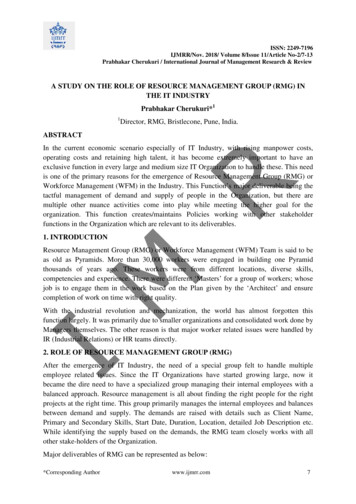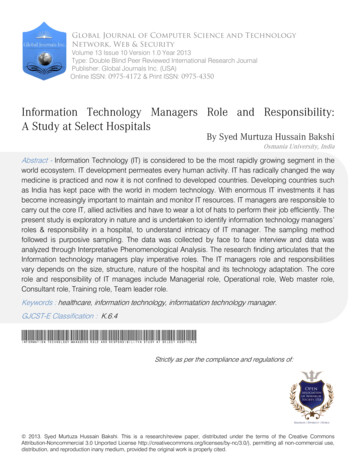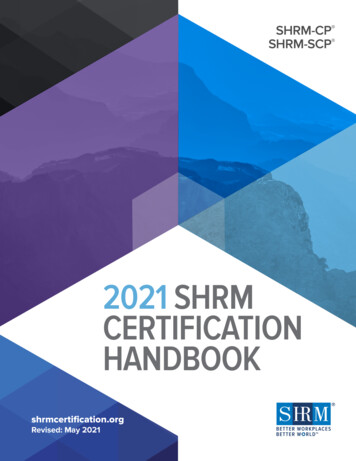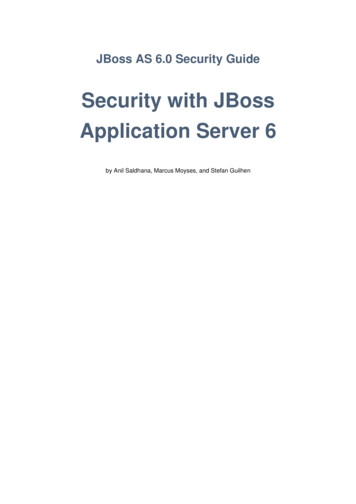
Transcription
ISSN: 2249-7196IJMRR/Nov. 2018/ Volume 8/Issue 11/Article No-2/7-13Prabhakar Cherukuri / International Journal of Management Research & ReviewA STUDY ON THE ROLE OF RESOURCE MANAGEMENT GROUP (RMG) INTHE IT INDUSTRYPrabhakar Cherukuri*11Director, RMG, Bristlecone, Pune, India.ABSTRACTIn the current economic scenario especially of IT Industry, with rising manpower costs,operating costs and retaining high talent, it has become extremely important to have anexclusive function in every large and medium size IT Organization to handle these. This needis one of the primary reasons for the emergence of Resource Management Group (RMG) orWorkforce Management (WFM) in the Industry. This Function’s major deliverable being thetactful management of demand and supply of people in the Organization, but there aremultiple other nuance activities come into play while meeting the higher goal for theorganization. This function creates/maintains Policies working with other stakeholderfunctions in the Organization which are relevant to its deliverables.1. INTRODUCTIONResource Management Group (RMG) or Workforce Management (WFM) Team is said to beas old as Pyramids. More than 30,000 workers were engaged in building one Pyramidthousands of years ago. These workers were from different locations, diverse skills,competencies and experience. There were different ‘Masters’ for a group of workers; whosejob is to engage them in the work based on the Plan given by the ‘Architect’ and ensurecompletion of work on time with right quality.With the industrial revolution and mechanization, the world has almost forgotten thisfunction largely. It was primarily due to smaller organizations and consolidated work done byManagers themselves. The other reason is that major worker related issues were handled byIR (Industrial Relations) or HR teams directly.2. ROLE OF RESOURCE MANAGEMENT GROUP (RMG)After the emergence of IT Industry, the need of a special group felt to handle multipleemployee related issues. Since the IT Organizations have started growing large, now itbecame the dire need to have a specialized group managing their internal employees with abalanced approach. Resource management is all about finding the right people for the rightprojects at the right time. This group primarily manages the internal employees and balancesbetween demand and supply. The demands are raised with details such as Client Name,Primary and Secondary Skills, Start Date, Duration, Location, detailed Job Description etc.While identifying the supply based on the demands, the RMG team closely works with allother stake-holders of the Organization.Major deliverables of RMG can be represented as below:*Corresponding Authorwww.ijmrr.com7
Prabhakar Cherukuri / International Journal of Management Research & Review3. STAKEHOLDERSRMG/WFM works closely with multiple stakeholders of the Organization starting from theCEO.i. Leadership Teamiii. Practices/Vertical Leadersv. Recruitmentvii. Immigrationix. Consultantsii. Sales & Presales Teamsiv. Delivery & Project Management Teamsvi. HRviii. FinanceCopyright 2018 Published by IJMRR. All rights reserved8
Prabhakar Cherukuri / International Journal of Management Research & ReviewMultiple Organizations follow different processes for their Demand and Supply Managementunder their RMG. In my study, I found below process as one of the best and simple workflowfollowed across many Organizations in the industry.From multiple deliverables of RMG, below are major and key to the success of theOrganization4. DEMAND MANAGEMENTDemand Management covers the process of receiving requests, fulfilling the requests withinthe agreed time-lines and with best fit people. Based on the Organizational Business Plan, thedemands are planned and forecasted by RMG.The resource requests arrive through various sources and for multiple reasons (Sources ofdemands).Demand typeUpcoming demandsNew RequirementsReplacement demandsProactive HiresSourceSales Team informs the capacity neededDelivery/Project Manager requests for new demands basedon his/her Project PlanDelivery/Project Manager requests for new demands basedon the existing employee performance/resignationTo plan for capacity enhancement for future requirements4.1 Supply ManagementOnce the Consultant is formally allocated to the demand in the Project with an end date, thedemand is treated as fulfilled. As and when the Project Manager releases the Consultant,he/she comes on to Pool (largely called as ‘Bench’). This is called as ‘Available Supply’.This team of Pool are of multiple skills/experience and levels. These Consultants are engagedin multiple activities across the Organization (such as Internal Projects, New projectfamiliarization, Presales activities) by RMG. RMG also initiates few proactive Visas basedon upcoming opportunities and needs. This would make the consultants travel ready andmotivates them.Based on the need, the RMG team gives notice to Hiring team to start working on therequirement to fulfil by hiring people.The RMG team also gathers feedback about these Consultants on Pool from their pastprojects. This feedback helps in nominating them for Trainings, upgrading their skills eithertechnical or behavioral. Usually these trainings are mandatory for people on Pool.This supply is visible across the Organization to stakeholders, to enable all know the skillsavailable and soft-block based on their need.UtilizationBased on the available Capacity and people deployed in Projects, the Utilization atOrganization is calculated, which is one of the KPI of any IT Organization. The input of thisinformation is the Timesheets submitted by Consultants.RMG always makes sure that Consultants submit their Timesheets on time and accurately.Copyright 2018 Published by IJMRR. All rights reserved9
Prabhakar Cherukuri / International Journal of Management Research & ReviewCompetencyRMG also defines the technical skill framework for the Organization. Each skill falls underone of the skill family. The framework also defines the Core and Non-Core skills. The Coreand Non-core nature of skills defines the timelines till which a Consultant can be maintainedin the ‘Available Supply’ or Bench.Based on the guidelines defined, RMG recommends certain actions to the Practice/Vertical orHR.Project forecastsMaximizing the profitability of a project (or of an organization) requires more than justmanaging actual costs, revenue, and profit. RMG works with Delivery/Project Managers toforecast the availability of people and next steps for future projects.Metrics & MISRMG publishes metrics to stakeholders for their information and support where needed.Some of these are:ØØØØØØØHead Count ReportBench/Available Pool ReportOpen DemandsDemands fulfilledCost of BenchSkill availability and Need to buildUtilization5. CHALLENGES FOR RESOURCE MANAGEMENT GROUP (RMG)Resource management challenges are the top issues facing organizations today, according toPM Solutions Research. This finding first surfaced in studies conducted on other topics in2016 – 2017, as well as during roundtable discussions at our Benchmarking Forums 2009 –2016.Ø Manual activities and huge costØ Resource capacity planning is poorØ Resource risks are not assessedØ Not enough appropriately skilled resourcesØ Resource use is not optimizedØ Schedules/deadlines are unrealisticØ Too many unplanned requests for resourcesØ Resource utilization is poorly documentedØ Shifting resources to respond to problemsØ Transition process for resources is inadequateCopyright 2018 Published by IJMRR. All rights reserved10
Prabhakar Cherukuri / International Journal of Management Research & ReviewBecause resource shortages and conflicts can plague your ability to deliver, understanding theresource capacity and skill sets that exist within your organization give you the ability tobalance demand and apply the right resources at the right time. This ability can make thedifference between successfully executing strategy and failing — failing to meet deadlines,deliver projects and services with the desired quality, or serve the interests of stakeholders.Further bad news is that resource management maturity is low in organizations. 74.4% oforganizations are at maturity level 1 or 2 according to a study. Organizations experiencesignificant challenges in all components of resource management, but particularly in resourceplanning and estimating; they even fail to practice many of the resource managementstandards noted by the Project Management Institute. To compound the problem, there is asignificant disconnect between decision makers who assume that there are enough resourcesfor all projects when there often are not.Almost half (47.9%) of all organizations use automated information systems to assist inresource management functions; but those who do are lukewarm in their description of thevalue of those systems. Of those who used these systems, almost half (47.3%) thought theydid not accurately calculate resource forecasts. More than half (55.0%) said their managersdid not use the systems consistently or effectively.Strategies to improve the effect of Resource Management:· Strategy #1: Automation of Resource management to the maximum· Strategy #2: Project portfolio management, which supports resource management maturity· Strategy #3: Standardizing project management culture and results through training andmethodology.6. RESULTSI could find that by following the above strategies, results can be as below:Reducing turnover48.50%Improving Quality and interaction insights57.60%Delivering improved service at lower/samecostsReducing Operating Costs59%66.70%Based on the need and growing demand, many organizations are moving towards Cloudsolutions. In my study, the trend looks like below:Copyright 2018 Published by IJMRR. All rights reserved11
Prabhakar Cherukuri / International Journal of Management Research & Review5%No Current Solution19%0%55%52.40%Currently using Excel/Spreadsheet solutions64%40%28.60%36%Currently On-Premise Softwares0%Within next 12-24 months10%20%30%40%Within next 6-12 months50%60%70%Within 6 monthsBased on the above, it looks like many organizations currently on manual solutions, plan tomove to automation tools either to cloud based or on-premise quite soon.How important it is moving to an automated solution on priority basis. What desired benefitsmoving to an automated solution would give?Not at all ImportantSightly ImportantModerately ImportantVery ImportantExtremely portantData Accuracy55.90%29.40%Transperancy of information33.80%26.50%Improved customer satisfaction26.50%41.20%Reduced manual 50.00%60.00%SightlyImportantNot at 4.40%7.40%19.10%2.90%5.90%7. CONCLUSIONEstablishing the Resource Management Group (RMG) as the communication center for allWorkforce Management makes it possible for the entire organizational culture, fromexecutives all the way through project teams, to communicate in a common language andwork together. In its primary role as Demand and Supply management team, it is veryCopyright 2018 Published by IJMRR. All rights reserved12
Prabhakar Cherukuri / International Journal of Management Research & Reviewimportant that the RMG team get enough support from other functions and get the benefits atOrganization level.With changing times, the role of RMG/WFM team’s deliverables and KPI also haveenhanced and not limiting to only fulfillments. This team discusses with Consultants andcontributes to reduction of attrition in the Organization, provides career path to theconsultants, does financial forecasting based on the external hiring and controls utilization.This team can be further efficiently managed by automating its multiple manual activities andintegrating with other tools of the Organization.REFERENCES[1] Study on Workforce Management by Project Management Institute (PMI).[2] Paper by PM Solutions on Resource Management and PMO.[3] My personal experience in last 15 years in the IT Industry.[4] Informal survey done and information gathered from multiple organizations.Copyright 2018 Published by IJMRR. All rights reserved13
Resource Management Group (RMG) or Workforce Management (WFM) Team is said to be as old as Pyramids. More than 30,000 workers were engaged in building one Pyramid thousands of years ago. These workers were from different locations, diverse skills, competencies and experience.











